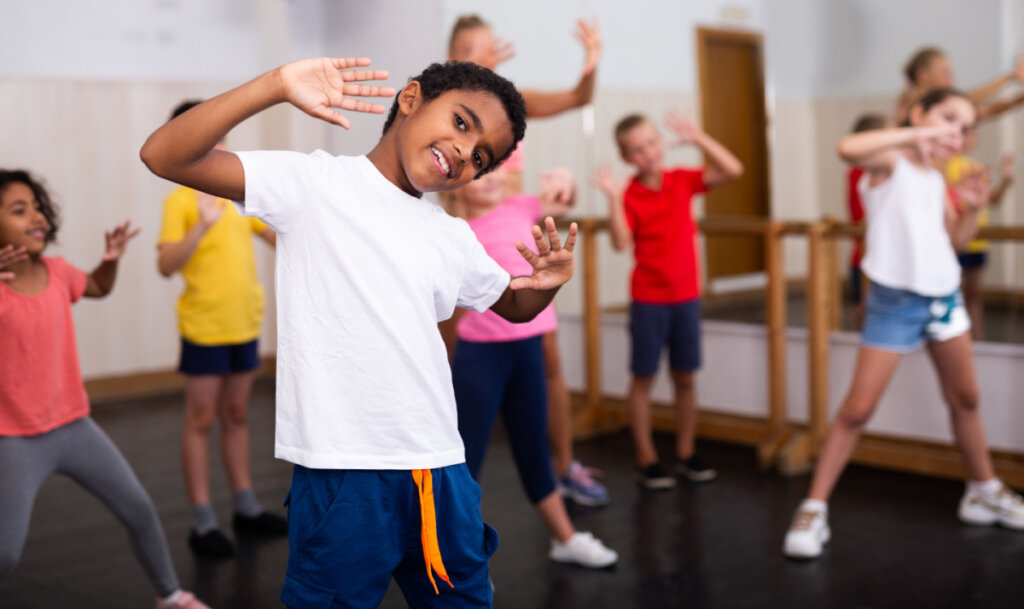The Benefits of Movement Based Learning (MBL)


Written and verified by the psychologist Elena Sanz
Traditionally, the teaching-learning process in educational institutions is carried out passively. Indeed, classrooms are full of children acting as passive receivers of information. However, this pedagogical style has significant shortcomings and limitations for all students, but especially for certain minorities. Therefore, it’s interesting to learn of some alternatives, such as Movement Based Learning (MBL).
As a matter of fact, some schools have already made certain improvements with regard to a more active form of learning. For instance, the implementation of active bursts. These breaks between one subject and another are small periods of movement that help children to clear their heads and activate their bodies and minds. However, the option we’re talking about in this article goes further and integrates movement as a fundamental part of the learning process.

Movement Based Learning (MBL)
This innovative methodology combats some of the main difficulties found in the classroom. For example, many teachers have to deal with children who constantly shift in their chairs, adopt inappropriate postures, talk, become distracted, or stop paying attention. In fact, in reality, the natural thing for them is not to remain static and passive. Moreover, exercise is necessary to improve their cognitive development and academic performance.
Therefore, the proposal of Movement Based Learning is to abandon the sedentary culture in the classroom, get children out of their chairs, and allow them to take an active role in their learning. In effect, they learn by doing, through action and interaction with the environment and people. Most importantly, they learn through the movement of their bodies.
The benefits of Movement Based Learning
Although, as we’re used to traditional schooling methods, MBL may seem like a strange or crazy proposition, it’s effective. Among its main benefits are:
1. It helps fight sedentary lifestyles and childhood obesity
Today, there’s currently a real epidemic of childhood obesity. In fact, between 35-40 percent of minors are overweight to some degree. In fact, children have become increasingly sedentary.
MBL helps to reverse this trend. It not only favors the physical but also the psychological health of minors. For example, research has proved that physical exercise helps overweight children improve their thinking ability and math skills.
2. It improves attention and impulse control
One of the populations with the most difficulties when it comes to adapting to the sedentary context of the classroom is children with attention deficit hyperactivity disorder (ADHD). It’s especially complex for them to regulate their attention and control their impulses. Movement can be useful.
Research suggests that physical activity facilitates the ability of children to focus their attention, concentrate and think, as well as switch between tasks. Response accuracy and stimulus processing (after exercise) were found to be improved in both healthy children and those with ADHD. In addition, in both groups, performance in the areas of reading and arithmetic improved.
3. It promotes cognitive processes
Other mental processes, such as creativity, perception, memory, verbal ability, and cognitive development, are also improved by exercise and movement. Physical activity can even promote improvements in intelligence quotient and academic performance.
4. It promotes more effective learning
Finally, (and this is undoubtedly the most sought-after goal in schools), MBL makes it easier for students to consolidate information.
On the one hand, this is due to the active role given to the child, who can interact with the information, thus generating significant learning. However, it’s also due to the fact that physical activity promotes synaptic plasticity and the growth of neurons in the hippocampus. This is the area of the brain related to memory and learning.

How to apply Movement Based Learning in the classroom
The benefits of this educational methodology are undeniable. That said, employing it on a daily basis in the classroom is a challenge. The teacher must be able to arouse the interest of the students and encourage them to engage their bodies in meaningful activities that allow them to explore, manipulate, and interact.
Creativity is key in achieving this. Proposals can range from options as simple as standing or free-motion pauses to more complex ones. For example:
- Generating a gym in the classroom with a theme, in accordance with the subject that the students are currently studying.
- Giving each student a piece of paper (with a term or definition) and asking them to look around the room for someone who has a paper corresponding to theirs.
- Devising a contest in which, to answer, they must make movements. For instance, jumping means “yes, and crouching means “no”.
The above are just a few suggestions, but the options are diverse. The key is that students don’t remain sedentary and that they involve their bodies in their learning. In addition, the activities should be meaningful and interesting.
Despite the effort required to design these types of educational sessions, they undoubtedly have a positive impact on learning, as well as the physical, mental, emotional, and social health of minors.
Traditionally, the teaching-learning process in educational institutions is carried out passively. Indeed, classrooms are full of children acting as passive receivers of information. However, this pedagogical style has significant shortcomings and limitations for all students, but especially for certain minorities. Therefore, it’s interesting to learn of some alternatives, such as Movement Based Learning (MBL).
As a matter of fact, some schools have already made certain improvements with regard to a more active form of learning. For instance, the implementation of active bursts. These breaks between one subject and another are small periods of movement that help children to clear their heads and activate their bodies and minds. However, the option we’re talking about in this article goes further and integrates movement as a fundamental part of the learning process.

Movement Based Learning (MBL)
This innovative methodology combats some of the main difficulties found in the classroom. For example, many teachers have to deal with children who constantly shift in their chairs, adopt inappropriate postures, talk, become distracted, or stop paying attention. In fact, in reality, the natural thing for them is not to remain static and passive. Moreover, exercise is necessary to improve their cognitive development and academic performance.
Therefore, the proposal of Movement Based Learning is to abandon the sedentary culture in the classroom, get children out of their chairs, and allow them to take an active role in their learning. In effect, they learn by doing, through action and interaction with the environment and people. Most importantly, they learn through the movement of their bodies.
The benefits of Movement Based Learning
Although, as we’re used to traditional schooling methods, MBL may seem like a strange or crazy proposition, it’s effective. Among its main benefits are:
1. It helps fight sedentary lifestyles and childhood obesity
Today, there’s currently a real epidemic of childhood obesity. In fact, between 35-40 percent of minors are overweight to some degree. In fact, children have become increasingly sedentary.
MBL helps to reverse this trend. It not only favors the physical but also the psychological health of minors. For example, research has proved that physical exercise helps overweight children improve their thinking ability and math skills.
2. It improves attention and impulse control
One of the populations with the most difficulties when it comes to adapting to the sedentary context of the classroom is children with attention deficit hyperactivity disorder (ADHD). It’s especially complex for them to regulate their attention and control their impulses. Movement can be useful.
Research suggests that physical activity facilitates the ability of children to focus their attention, concentrate and think, as well as switch between tasks. Response accuracy and stimulus processing (after exercise) were found to be improved in both healthy children and those with ADHD. In addition, in both groups, performance in the areas of reading and arithmetic improved.
3. It promotes cognitive processes
Other mental processes, such as creativity, perception, memory, verbal ability, and cognitive development, are also improved by exercise and movement. Physical activity can even promote improvements in intelligence quotient and academic performance.
4. It promotes more effective learning
Finally, (and this is undoubtedly the most sought-after goal in schools), MBL makes it easier for students to consolidate information.
On the one hand, this is due to the active role given to the child, who can interact with the information, thus generating significant learning. However, it’s also due to the fact that physical activity promotes synaptic plasticity and the growth of neurons in the hippocampus. This is the area of the brain related to memory and learning.

How to apply Movement Based Learning in the classroom
The benefits of this educational methodology are undeniable. That said, employing it on a daily basis in the classroom is a challenge. The teacher must be able to arouse the interest of the students and encourage them to engage their bodies in meaningful activities that allow them to explore, manipulate, and interact.
Creativity is key in achieving this. Proposals can range from options as simple as standing or free-motion pauses to more complex ones. For example:
- Generating a gym in the classroom with a theme, in accordance with the subject that the students are currently studying.
- Giving each student a piece of paper (with a term or definition) and asking them to look around the room for someone who has a paper corresponding to theirs.
- Devising a contest in which, to answer, they must make movements. For instance, jumping means “yes, and crouching means “no”.
The above are just a few suggestions, but the options are diverse. The key is that students don’t remain sedentary and that they involve their bodies in their learning. In addition, the activities should be meaningful and interesting.
Despite the effort required to design these types of educational sessions, they undoubtedly have a positive impact on learning, as well as the physical, mental, emotional, and social health of minors.
All cited sources were thoroughly reviewed by our team to ensure their quality, reliability, currency, and validity. The bibliography of this article was considered reliable and of academic or scientific accuracy.
- Davis, C. L., Tomporowski, P. D., McDowell, J. E., Austin, B. P., Miller, P. H., Yanasak, N. E., … & Naglieri, J. A. (2011). Exercise improves executive function and achievement and alters brain activation in overweight children: a randomized, controlled trial. Health psychology, 30(1), 91.
- Pontifex, M. B., Saliba, B. J., Raine, L. B., Picchietti, D. L., & Hillman, C. H. (2013). Exercise improves behavioral, neurocognitive, and scholastic performance in children with attention-deficit/hyperactivity disorder. The Journal of pediatrics, 162(3), 543-551.
- Sattelmair, J., & Ratey, J. J. (2009). Physically Active Play and Cognition: An Academic Matter?. American journal of play, 1(3), 365-374.
- Sibley, B. A., & Etnier, J. L. (2003). The relationship between physical activity and cognition in children: a meta-analysis. Pediatric exercise science, 15(3), 243-256.
This text is provided for informational purposes only and does not replace consultation with a professional. If in doubt, consult your specialist.







